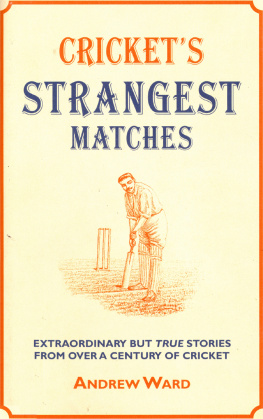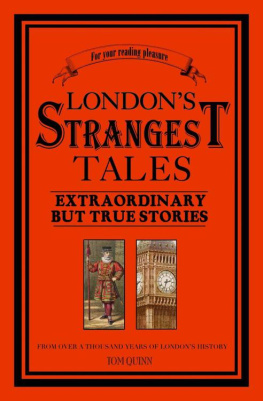


www.anovabooks.com
Other titles in the STRANGEST series
The Ashes Strangest Moments
Boxings Strangest Moments
Bridges Strangest Hands
Cinemas Strangest Moments
Classical Musics Strangest Concerts
Cornwalls Strangest Tales
Crickets Strangest Moments
Dublins Strangest Tales
Fishings Strangest Days
Flyings Strangest Moments
Footballs Strangest Matches
Gamblings Strangest Moments
Golfs Strangest Rounds
Horse-racings Strangest Races
Kents Strangest Tales
Laws Strangest Cases
Londons Strangest Tales
London Undergrounds Strangest Tales
Medicines Strangest Cases
The Militarys Strangest Campaigns
Motor-racings Strangest Races
The Olympics Strangest Moments
Pokers Strangest Hands
Politics Strangest Characters
Railways Strangest Journeys
Rock n Rolls Strangest Moments
Royaltys Strangest Characters
Rugbys Strangest Matches
Sailings Strangest Moments
Sciences Strangest Inventions
Shootings Strangest Days
Televisions Strangest Moments
Tenniss Strangest Matches
Theatres Strangest Acts
Yorkshires Strangest Tales
This edition published by
Portico
10 Southcombe Street
London
W14 0RA
An imprint of Anova Books Group Ltd
Copyright Andrew Ward 1989, 1999, 2002
First published in 1989 as Soccers Strangest Matches.
The moral right of the author has been asserted.
All rights reserved. No part of this publication may be reproduced, stored in a retrieval system, or transmitted in any form or by any means electronic, mechanical, photocopying, recording or otherwise, without the prior written permission of the copyright owner.
First eBook publication 2013
ISBN 9781909396272
Also available in paperback
ISBN 9781861052926
This book can be ordered direct from the publisher at
www.anovabooks.com
Introduction
In the beginning they were all strange games. When the first official club Sheffield, in 1857 was formed, there were no other teams to play against. So the bachelors played the married men until a nearby garrison put up a challenge. And one early Sheffield rule stipulated that players must hold half-crown coins while they played to prevent pushing with the open hand.
In compiling the first edition of this book I tried to avoid such weird evolutionary encounters, opting instead for games played under more formal rules as we know them. Each game was strange in that it provided some new experience for spectators or players. Sometimes people went to a game expecting novelty, as happened with the hypnotist at Hinckley or the New Bedford men against the Preston women. On other occasions one person has made a spectacular impact on the game, whether through failure (like Jimmy Warner of Aston Villa), success (like Wilfred Minter of St Albans City) or a perverse mixture of both (like Chris Nicholl of Aston Villa). But the most obvious candidates for inclusion are those games in which events have simply departed from football tradition and entered a new world, beyond the control of the participants. Who could anticipate a dog heading a goal or a referee scoring the winning goal of a Football League match?
Strangeness, of course, is relative and culturally rooted. Inevitably, this collection is a personal selection. It draws heavily on the British professional scene, the section of soccer history with which I am most familiar, and only occasionally crosses national boundaries. I suspect that there have been even stranger matches around the world, or in the local leagues, well deserving of mention. For instance, I have heard of a player scoring the winning goal without stepping on to the field; apparently, as a substitute, he immediately took a corner-kick and fell over with a broken ankle as the ball curled into the net. And an editor friend, Graham Hart, once asked me how a player could score three goals without any other player touching the ball. The answer, in case you havent worked it out, is that he scores an own goal, picks the ball out of the net, carries it to the halfway-line, kicks off by angrily punting the ball high in the air and runs after it full-pelt. He is just inside the penalty area when he is tripped, whereupon he grabs the ball (still not touched by anybody else), puts it on the penalty spot, slams it into the net and runs, Eusebio-like, to collect it himself. The referee blows for half-time, so the player hangs on to the ball andhis team has the kick-off. Once more he punts the ball high in the air and, lo and behold, he is tripped again and scores from another penalty, his third goal without anyone else touching the ball.
Since the first edition was published, in 1989, people have kindly written to me with suggestions for matches that could have been included. I wish I had known at the time about Jockeys v Boxers (1913) and the motor-bike matches of the 1930s. I wish I had researched the details of St Mirrens 11-day boat trip to play Notts County at Barcelonas new ground in 1922 and West Auckland Town winning the Sir Thomas Lipton Trophy (1909 and 1911). But no book on strange matches can be comprehensive.
Some of the stories in this book, like Wilfred Minters Goalscoring Feat, have become stranger in the light of the modern game. Other events, such as law cases and protracted penalty shoot-outs, have become more common. In future we may see headlines like Law Court Decides Match Result and Penalty Shoot-out Halted by Breakfast.
I have updated the book with additional stories but have not changed the original text substantially. Certain stories could be expanded on the basis of new information. For instance, more is known about The War Game through books such as Christmas Truce by Malcolm Brown and Der Kleine Frieden im Grossen Krieg (The Small Peace in the Big War) by Michael Jrgs. And Dan Gordon and Nick Bonner have now told the story of the 1966 North Korea team in their award-winning documentary The Game of Their Lives. But the only story I have changed for this edition is The Crossbar Protest which had factual errors in the original.
Earlier versions of three of these stories appeared in The Footballer magazine. My sincere thanks, also, to Ian Alister, Jo Bradley, Antony Burr, Malcolm Chamberlain, Graham Clayton, David Davies, Helen Davison, John Dewhirst, Mr H Finch, John Harding, Eric Hayes, Ewa Huggins, Robert Jackson, Alan Jenkins, Graham Kelly, Kevin McCarra, Clem MacIntyre, Haydn Middleton, Mark Neale, Anton Rippon, John Watmough, Steve Way, Mr C J Wigginton, Richard Wiseman, Pat Woods and Keith Wright.
Andrew Ward
THE ZULU WARRIORS
SHEFFIELD, NOVEMBER 1879
In January 1879 Cetewayo, the Zulu king, marshalled some 50,000 warriors to repel the British armys invasion of Zululand. The Zulu warriors fought with assegais, spears and ox-hide shields, and wore uniforms that were no more than a tuft of hair acting as a loin-cloth, but were well-organized and disciplined. The British completely underestimated them. After bloody battles at Isandhlwana and Rorkes Drift it wasnt until August that the Zulu force was overcome. The British army lost over 1,300 men, about 1,000 natives and the French Prince Imperial, who was in their charge. Zulu loss of life was even greater. The Zulu War also heralded the breakdown of the Zulu kingdom. Cetewayo was captured, British Zululand was eventually handed over to the colony of Natal and it became part of the Republic of South Africa.























